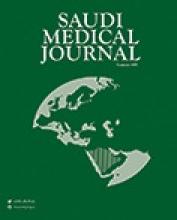Abstract
OBJECTIVE: To further assess the safety, efficacy, and results of the percutaneous trigger finger release, using the tip of an 18-gauge needle.
METHODS: At King Hussein Medical Center, Amman, Jordan, from January 2004 to January 2006, 42 patients with trigger fingers were treated with percutaneous A1 pulley release. The operations were performed using the tip of an 18-gauge hypodermic needle, to release the A1 pulley, by an experienced orthopedic hand surgeon. There were 24 women and 18 men. The mean age of the patients was 56 years (range 32-75 years). The mean duration of follow-up was 18 weeks. The results were classified as satisfactory if the treated finger was no longer clicked or locked and was comfortable, and as unsatisfactory if there was persistent discomfort or if open surgery were required.
RESULTS: Satisfactory results were achieved in 39 cases (92.8%) in which fingers were completely free from triggering. There were 3 cases (7.2%) in which treatment failed to relieve the symptoms, residual triggering was still found, and all 3 cases were diabetic. These 3 cases required open release.
CONCLUSION: Percutaneous A1 pulley release is an effective, safe, and convenient procedure for the treatment of trigger finger. It is well tolerated by patients and should be the treatment of choice for the established trigger finger. It must be carried out by an experienced orthopedic hand surgeon to ovoid serious complications.
- Copyright: © Saudi Medical Journal
This is an open-access article distributed under the terms of the Creative Commons Attribution-Noncommercial-Share Alike 3.0 Unported, which permits unrestricted use, distribution, and reproduction in any medium, provided the original work is properly cited.






